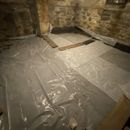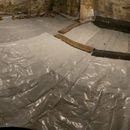Controlling Humidity in an Old Basement
I have a Victorian house in western Massachusetts that was built in the 1880s. The unfinished basement is 1,700 square feet. And one of the rooms of the basement is problematic. It is 234 square feet and the concrete floor is all busted up, the floor is always damp, and the room is constantly humid, over 60% RH.
There is a French drain along one wall in that room which leads to a sump pump. There is also a French drain channel that goes from the middle of the room to the French drain against the wall.
The walls of this room are field stone and then brick. Once in a while water seeps through the wall in one place right where the French drain is located.
We rarely go into this room so I currently have plastic on the floor in an effort to reduce humidity. I know I should tape the seams of the plastic on the floor to better seal in humidity. But I can’t decide what to do about the walls.
If I encapsulate the walls with plastic sheets or another vapor barrier (assuming I use caulking to create a tight seal on the wall), then wouldn’t moisture be trapped between the stone/brick and the newly hung plastic? Wouldn’t that be bad for the brick and stone over the long term?
I was thinking of painting the wall with Drylok (using their etching and cleaning product first) but then read an article about how to fix historic brick and stone walls which recommended against painting the walls.
In this room I have a GE dehumidifier, Model APEL509LZQ1, 50 pints a day. In another part of the basement I have another dehumidifier, Frigidaire, Model LAD704TDL, 70 points a day.
In retrospect I should have bought one E-series Aprilaire dehumidifier for the whole basement.
So… does anyone have any suggestions on what I should do about the problematic room? (please note: I am in the process of trying to prevent water from seeping inside the house. I am planning to have a landscaping company grade around the house and install a french drain along the parts of the house where water sometimes seeps in.)
GBA Detail Library
A collection of one thousand construction details organized by climate and house part












Replies
I'll share a response Mike Guertin gave to a related question because it points to a few things you may not have considered (like doors): "The problem may be due to warm, humid air entering the space from the outside rather than through the slab or walls. Doors are notoriously leaky. When warm air leaks into a basement, the air cools and the relative humidity increases. If the air temperature reaches the dew point, moisture can condense on surfaces such as the slab or walls. Eliminating the doors is usually not an option, so the best approach is to air-seal them well. If the door is old, a new insulated model with better weather-sealing may help. If doors have been air-sealed and there are none of the other air leaks common to a basement and still the problem persists, then I’d address the floor and walls, which can transfer moisture from the surrounding soil. Exterior site drainage or interior water management would alleviate that problem, but I don’t recommend moisture-blocking paint. It can work, but it’s not a long-term fix for this problem, and it can be hard to clean the concrete well enough to get a reliable bond."
Seems to me this house survived 240 years the house has found a way balance the moisture entering and exiting the basement.
While I am sure your efforts the make the house more energy efficient are well meaning please consider your choices carefully understand when you stop the leaks around the drafty windows upstairs you are changing the air flow thru the basement.
Consider when you add insulation you are changing the way heat and flows thru the house that heat may be the difference between water vapor harmlessly exiting your home or the moisture condensing in the walls leading to rot and mold.
The first thing I would do is work on the exterior to try to keep liquid water from entering the basement. Think about regrading so water runs away from the building. Are the gutters and down spouts are in good working order?
Walta
Thanks for this response Walta,
I totally agree with your recommendation to deal with the exterior and keeping water away from the house. I am working to hire a company to install ground gutters and drain pipes to carry the water away from the house and to grade too. This past May I did add insulation to the attic and 3rd floor walls but the humidity problem existed I added the insulation. In May I also had the house sealed. I have to doubt that the insulation and sealing might contribute to increased moister in the house.
The house does not have gutters. If possible I'd like to avoid adding them since I'm afraid in the winter, a lot of snow and ice will build up on them and they'll fall off. Half the houses in my town have gutters that have split away from the house or look like they are about to split away. I got a few bids for installing gutters in one key spot but the installers wanted to use vampire strap which I doubt will hold up. The one company that would have attached the gutters to the molding and would use blocks behind the gutter to help keep it in place never sent me a proposal. I ask them about guarantees about coming back to fix the gutters if they fell off and I guess they decided they didn't want my business.... :)
There's three principal ways that moisture can get into a basement:
1. Liquid water leaking in through cracks in the walls and floor.
2. Water vapor wicking through the foundation.
3. Water vapor arriving in warm, humid air, either from the outside in summer, or the interior of the house year-round.
The liquid water you really want to control at the source, keeping it away from the foundation. It sounds like you're addressing that.
In terms of vapor wicking through the foundation you need an interior vapor barrier. As to whether this will trap moisture that will be bad for the brick, I think the risk is slight. This is not liquid water. Keeping that out is the big issue because it is a big risk. Above grade your foundation can still dry to the exterior, and in general that will be the direction of the moisture drive. Below grade, you're never going to dry the ground out around your house through the basement, that wall is always going to be damp on the exterior. Does it harm it to be somewhat more damp? I don't know, but probably not.
In terms of keeping warm humid air out, the first step is relentlessly sealing your basement, especially the rim joists. It's usually not possible to keep interior air out of the basement so there you may have to rely on the dehumidifier.